Cappadocia, the second day
First stop on the tour was the Red Valley overlook.
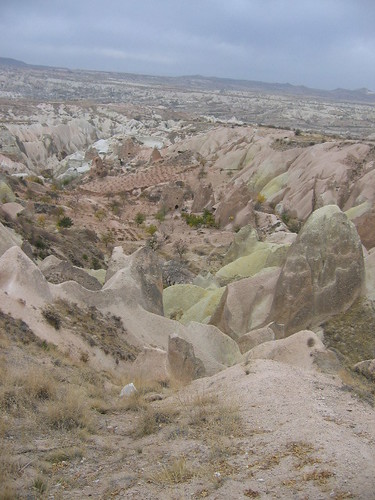
Next stop: Goreme.
The Goreme Open Air Museum is on the site of an old religious town.
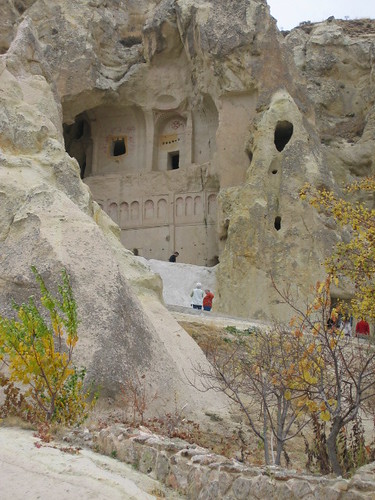
There are several churches, monasteries, and nunneries. Some of them were built in the 6 century, but most of them are from the 9th century. Often times there were several levels above ground to these places, but time has not been kind to these passageways as many of them have collapsed, so one can only get to the ground floor in many of them. Even so, one could still pass through the many other passages connecting the existing rooms. Some of the places I saw were old dining rooms, kitchens, and chapels.

As much as possible was carved out of the rock. In the dining rooms, the eating and sitting surfaces were rock, and were probably covered by carpets, kilims and/or cushions to make them more comfortable. Little nooks had been carved out of the wall for storage and pits had been dug out of the floor for fires. Just walking through, everything looked bare and pale, but I tried to imagine what it had been like, carpets on the floors, curtains hanging from the windows, fires crackling in the pits, people calling out to each other, and dishes clanking together as a meal was being prepared.
After I wandered around the tourist shops for a bit, Ismail and I headed for Uchisar, the Rock Castle. On the way, we stopped at his friend's onyx workshop. (Ismail doesn't have time to make onyx sculptures anymore.) His friend showed me how the process for making these little works of art.
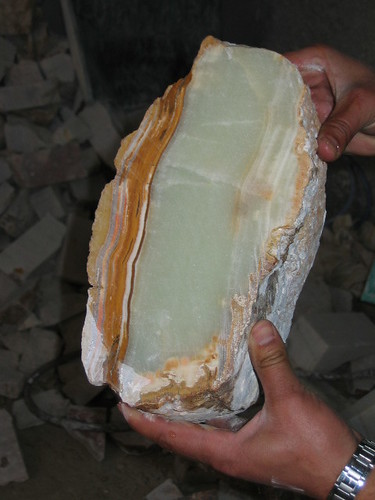
First you start with solid onyx.
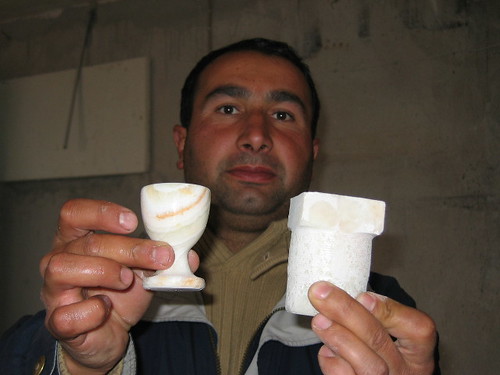
Then you cut it into a block using a diamond blade. See the square thingee on the right block? That is used to hold the rock in place while it is turned round and round in the carving machine.
You can do any shape you want: elephants, egg holders, vases, lamps, chess boards, etc.
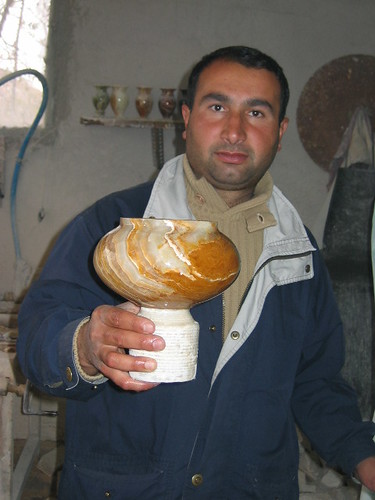
Cut off extra block on bottom. Polish. Viola! You have an onyx sculpture.
This is very dusty work and I am concerned about the effects of the dust on the lungs.
So then Uchisar. It can be seen a long distance away and provides a gorgeous view of a portion of the Cappadocia area. As it was a cloudy day, my photos of this didn't turn out as so nicely, so you'll just have to imagine what it looked like.
After that, we went to Pashabagi (pasha-baaah), a collection of fairy chimneys in which people once lived. Here is how the area formed.

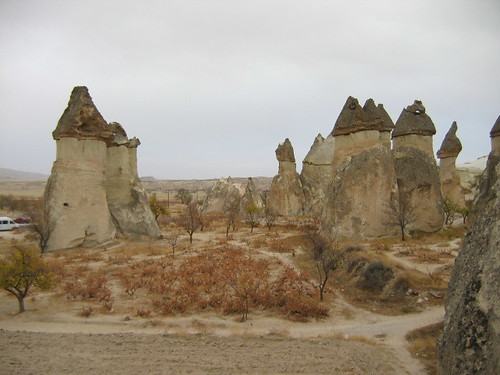
A couple ladders were available in case anyone wanted to climb in, which I did, and lost all my pocket's contents in the process. Nothing like dusty candy!
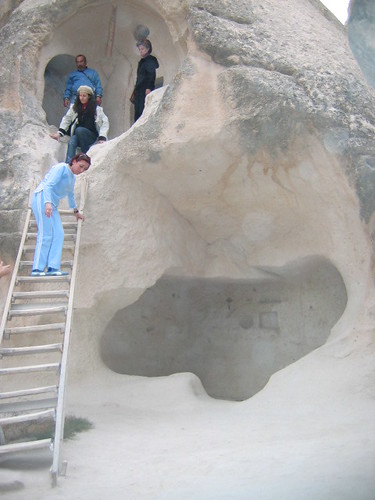
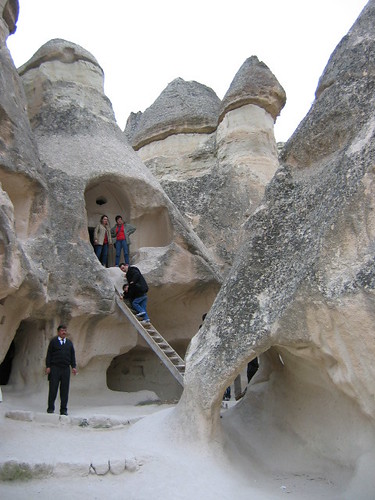
For lunch we went to an itty-bitty town called Zelva. I had gozleme, which is dough rolled thin with a long, narrow stick into a circle (much like yufka--see "How to make Borek"). Meat, cheese or spinach is put on the bottom half of the circle with a pat of butter and the other half is folded down. Then it is cooked on a big rounded metal circle shaped like a mushroom with fire underneath. It was in this place that I met Sehan Hanim, another of the guests from the hotel. She didn't speak a word of English, but could sometimes understand me if I spoke in English. Mostly I spoke Turkish on this trip, though. Sehan Hanim is 65, from Adana, and full of life. We had great laughs together.
Ismail invited Sehan Hanim and her family along to go to the last stop: Avanos. This town is famous for one particular pottery shop, where they teach you how to throw a pot.
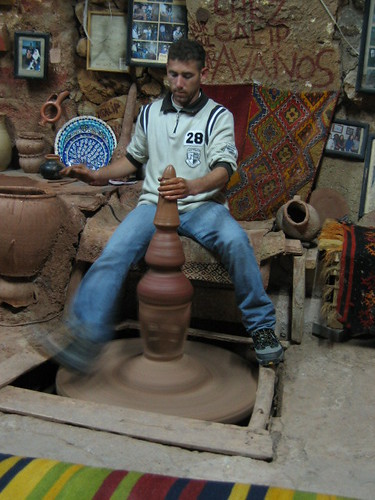
We entered the place and sat on colorful benches where a man showed us how to throw a jug. First he pounded all the air out of the clay, and then he sat down at a kick wheel and most elegantly formed a red clay jug. A tour of the place followed into various cave rooms full of various pottery pieces.
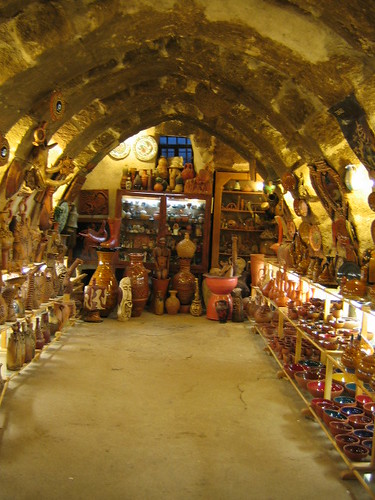
The pottery was beautiful and included huge plates, small plates, ashtrays, bowls, vases, and jugs. Every piece was painted in a different style with colors spanning the rainbow.
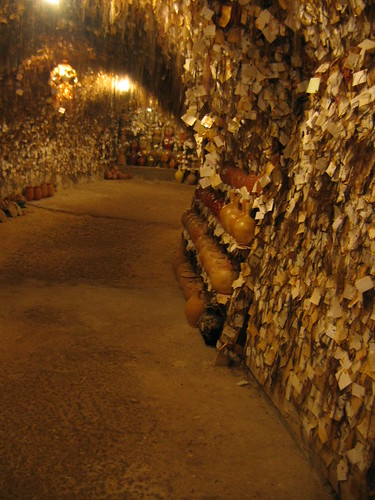
This pottery shop also holds the Guiness Book of World's Record for the largest hair collection. I don't know how many strands of hair they have, although I'm sure it's over 10,000. One of the pottery guys started his collection about 10 years ago (if I remember correctly) by taking strands of hair from women only. Every year they randomly choose 10 strands and those women win a 15-day vacation where they can choose to ride horses all week or learn how to throw pots. So I tried my luck and added my hair to the collection.
By this time, I was dead tired. As soon as I got back to the hotel, I laid down in my new and heated (!) room and promptly fell asleep for four hours! I woke up at midnight and found my new friends sitting in the parlor drinking Cappadocian wine. They all spoke English, so we had great conversations. A few hours later, I went back to bed.

Next stop: Goreme.
The Goreme Open Air Museum is on the site of an old religious town.

There are several churches, monasteries, and nunneries. Some of them were built in the 6 century, but most of them are from the 9th century. Often times there were several levels above ground to these places, but time has not been kind to these passageways as many of them have collapsed, so one can only get to the ground floor in many of them. Even so, one could still pass through the many other passages connecting the existing rooms. Some of the places I saw were old dining rooms, kitchens, and chapels.

As much as possible was carved out of the rock. In the dining rooms, the eating and sitting surfaces were rock, and were probably covered by carpets, kilims and/or cushions to make them more comfortable. Little nooks had been carved out of the wall for storage and pits had been dug out of the floor for fires. Just walking through, everything looked bare and pale, but I tried to imagine what it had been like, carpets on the floors, curtains hanging from the windows, fires crackling in the pits, people calling out to each other, and dishes clanking together as a meal was being prepared.
After I wandered around the tourist shops for a bit, Ismail and I headed for Uchisar, the Rock Castle. On the way, we stopped at his friend's onyx workshop. (Ismail doesn't have time to make onyx sculptures anymore.) His friend showed me how the process for making these little works of art.

First you start with solid onyx.

Then you cut it into a block using a diamond blade. See the square thingee on the right block? That is used to hold the rock in place while it is turned round and round in the carving machine.
You can do any shape you want: elephants, egg holders, vases, lamps, chess boards, etc.

Cut off extra block on bottom. Polish. Viola! You have an onyx sculpture.
This is very dusty work and I am concerned about the effects of the dust on the lungs.
So then Uchisar. It can be seen a long distance away and provides a gorgeous view of a portion of the Cappadocia area. As it was a cloudy day, my photos of this didn't turn out as so nicely, so you'll just have to imagine what it looked like.
After that, we went to Pashabagi (pasha-baaah), a collection of fairy chimneys in which people once lived. Here is how the area formed.
It took millions of years for the
ash from these volcanoes to form a
layer of tuff, covered in places by
a further layer of basalt lava. The
basalt ultimately cracked and split
under attack from the weather and
rainwater seeped down through the
cracks and splits to slowly erode
the tuff itself. The natural effects
of alternating very hot and very cold
weather and the rain and the wind
breaking down the rock's resistance
caused (and continues to cause) the
emergence of the tall cones of tuff
capped by hard basalt which the Turks
call Fairy Chimneys.*


A couple ladders were available in case anyone wanted to climb in, which I did, and lost all my pocket's contents in the process. Nothing like dusty candy!


For lunch we went to an itty-bitty town called Zelva. I had gozleme, which is dough rolled thin with a long, narrow stick into a circle (much like yufka--see "How to make Borek"). Meat, cheese or spinach is put on the bottom half of the circle with a pat of butter and the other half is folded down. Then it is cooked on a big rounded metal circle shaped like a mushroom with fire underneath. It was in this place that I met Sehan Hanim, another of the guests from the hotel. She didn't speak a word of English, but could sometimes understand me if I spoke in English. Mostly I spoke Turkish on this trip, though. Sehan Hanim is 65, from Adana, and full of life. We had great laughs together.
Ismail invited Sehan Hanim and her family along to go to the last stop: Avanos. This town is famous for one particular pottery shop, where they teach you how to throw a pot.

We entered the place and sat on colorful benches where a man showed us how to throw a jug. First he pounded all the air out of the clay, and then he sat down at a kick wheel and most elegantly formed a red clay jug. A tour of the place followed into various cave rooms full of various pottery pieces.

The pottery was beautiful and included huge plates, small plates, ashtrays, bowls, vases, and jugs. Every piece was painted in a different style with colors spanning the rainbow.

This pottery shop also holds the Guiness Book of World's Record for the largest hair collection. I don't know how many strands of hair they have, although I'm sure it's over 10,000. One of the pottery guys started his collection about 10 years ago (if I remember correctly) by taking strands of hair from women only. Every year they randomly choose 10 strands and those women win a 15-day vacation where they can choose to ride horses all week or learn how to throw pots. So I tried my luck and added my hair to the collection.
By this time, I was dead tired. As soon as I got back to the hotel, I laid down in my new and heated (!) room and promptly fell asleep for four hours! I woke up at midnight and found my new friends sitting in the parlor drinking Cappadocian wine. They all spoke English, so we had great conversations. A few hours later, I went back to bed.

1 Comments:
At 9:43 AM, nicole said…
nicole said…
Yes! That's something I was struggling with, as the situation unfolded itself. Now that you mention it, I have been grappling with this issue since I got here. How flexible should I be without compromising my own values? How many of my values can I apply here without being culturally insensitive? It's a hard balance to strike, and sometimes I am not as strong as I want to be. As time passes though, I'm getting better at figuring out where that balance is.
Thanks, Allison!
Post a Comment
<< Home